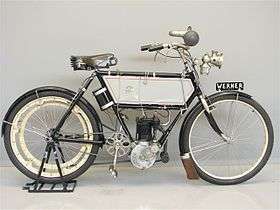New Werner
The New Werner was a motorcycle produced by Werner Motors beginning in 1901. It replaced Werner's 1897 model, whose motor placed above the front wheel caused handling problems.[2][3] Production ceased in 1908.[4] Some 50, now known as the "Leitner Rossiya Motorcycle", were also produced under license in Russia with Fafnir engines at the Riga bicycle works.[4]
 1904 Werner | |
| Manufacturer | Werner Motors |
|---|---|
| Production | 1901–1908 |
| Predecessor | Werner 1897 "Motocyclette" |
| Engine | 217 cc single-cylinder, four-stroke, surface carburetor |
| Bore / stroke | 62 × 72 mm |
| Power | 1.5 hp (1.1 kW) |
| Ignition type | Platinum hot tube ignition or battery and trembler coil |
| Transmission | Rawhide belt drive |
| Weight | c. 100 lb (45 kg)[1] (dry) |
The New Werner's lasting innovation was to place the engine at the lowest point in a bicycle-style diamond frame, where a bicycle crank would have been (the bicycle pedals, crank and redundant chain were relocated rearward and retained for starting and hillclimbing assistance). The pattern of low-mounted engine inside some kind of motorcycle frame became the standard motorcycle layout for the 20th century.[5][6][7][8]
The intake valve was automatic (actuated by atmospheric pressure) and the exhaust valve was cam driven.[9]
At 30 miles per hour (48 km/h), it was the fastest production motorcycle from the time it was introduced until the 1911 model year FN Four was introduced.
The New Werner was selected by Cycle World's Kevin Cameron as the most influential motorcycle of all time.[10] It was shown in the Guggenheim Museum's 2001–2003 The Art of the Motorcycle exhibition in Las Vegas.
Notes
- Kelly, p. 61
- Grace's Guide
- Bonhams: "The [1897] Werner, however, was not without its shortcomings, not the least of which was the dreaded 'sideslip', a consequence of the design's high centre of gravity, whereupon the hot tube ignition would cause the fallen machine to catch fire."
- Kelly, p. 56
- Louis and Currie, p. 22: "The Werner engine position was so logical, so absolutely right, that the new machine was to be the prototype of motor cycles for years ahead."
- Setright 1976, p. 15: "[T]he New Werner provided an archetype for the modern motorcycle, the crystalline form that was to be multiplied and mirrored a thousand times... in which they passed from being experimental playthings of a lunatic minority to becoming the recreational or workaday transport of a considerable number."
- Setright 1979, p. 26: "the layout [was] copied everywhere..."
- Bonhams: "The 1901 Werner is generally acknowledged as the first powered two-wheeler to carry its engine in the frame where the bicycle's bottom bracket and pedalling gear had been located, and thus is credited as the progenitor of the modern motorcycle.
- Louis and Currie, p. 22
- Cameron 2012
References
- c.1908 Werner 230cc — Frame no. 1911 — Engine no. 1C10CN-201270, Bonhams, February 5, 2011, retrieved 2013-10-22
- Cameron, Kevin (January 19, 2012), "The Five Greatest Motorcycles", Cycle World
- Werner Motors, Grace's Guide to British Industrial History, March 31, 2013, retrieved 2013-04-20
- Kelly, Maurice A. (2009), Russian Motor Vehicles: The Czarist Period 1784 to 1917, Veloce Publishing Ltd, ISBN 9781845842130
- Louis, Harry; Currie, Bob (1976), The classic motorcycles (1st ed.), New York: Dutton, ISBN 0525082034
- Setright, L.J.K. (1976), Motorcycles, London: Arthur Baker, OCLC 2692115
- Setright, L.J.K. (1979). The Guinness Book of Motorcycling Facts and Feats. Guinness Superlatives. pp. 8–18. ISBN 0-85112-200-0.
See also
External links
| Wikimedia Commons has media related to New Werner motorcycle. |
- Werner 1903, Yesterday's Antique Motorcycles (Nederweert, the Netherlands)
| Records | ||
|---|---|---|
| Preceded by Hildebrand & Wolfmüller |
Fastest production motorcycle 1901–1911 |
Succeeded by FN Four |